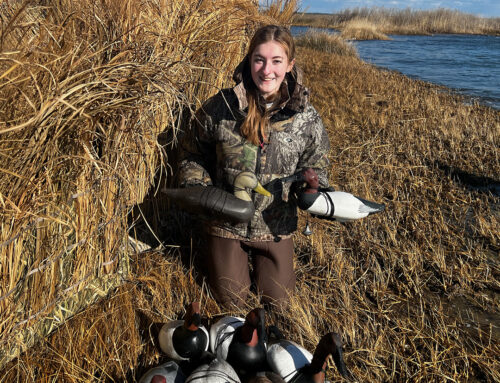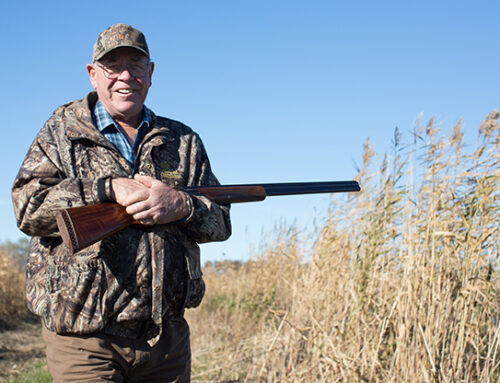Torturous Fun

A Chesapeake Bay sea duck hunt tests the limits of hunters and gear
By Brad Heidel
As the calendar flipped to 2019, I was excited to be headed to Chesapeake Bay — a storied duck-hunting destination I had read about many times, but had never visited for a hunt.
The famed market-gunning era of the 1800s and early 1900s ran strong on Chesapeake Bay. Duck hunting was a way to earn much-needed money for many trying to scratch out a living in difficult times. Although market gunning has long been outlawed, men still ply the Chesapeake in extreme conditions to make a living fishing for crabs and oysters. Some earn extra money guiding duck hunters on the side to make ends meet. “Back in the day,” these watermen would easily bring home a limit of 150 bushels of oysters a day. Now, they are lucky to bring in 60. For some of them, it can be more profitable to guide hunters out on the icy-cold waters than pull oysters. The captain for my hunt was one of these men.

Testing Guns
Beretta, which recently released the new A400 Xtreme Plus, set up a series of hunts to demonstrate that the semi-automatic shotgun can handle extreme conditions. Dubbed “The Torture Tour,” five branded shotguns would travel to some of the most hostile waterfowl environments in North America. These Italian-made shotguns would be fired at fowl in the fields of Alberta, handle the spray of the Great Salt Lake, hang on trees in the flooded timber of Arkansas, and finally, make a final stop in a brackish bay just off the Atlantic Ocean in January. I was one of the final five waterfowl hunters to put the guns to the test on the salty Chesapeake.
The forecast for our first hunt called for a full day of rain with strong offshore winds. The crew woke to calm winds, no rain and a temperature of 45 degrees. Not very extreme for that time of year in that climate.
We awoke early and headed for the docks, where we met Captain Wade of Barneck Outfitters in Tilghman Island, Maryland. We climbed about his boat, a 43-foot Chesapeake Bay deadrise — a traditional work boat used by watermen to catch blue crabs, fish and oysters. The vessel is marked by a sharp bow that expands down the hull into a large V shape and a square stern. When it isn’t used for fishing, it is perfect for hauling hunters and plastic trash cans filled with decoys.
As we headed out of the security of the harbor, I was amazed at the darkness. We cruised about three miles before we reached our blind. I really did not know what to expect, but as we approached I could clearly see a pontoon boat. Our hide was an old 17-foot pontoon boat. The boat had been stripped down to the deck, and then topped with a four-foot tall box. Cedar bows were attached to outside of the blind.
I was skeptical of this setup. Captain Wade quickly pulled the anchor on the pontoon blind, tied it off to our deadrise, and we were off again in the darkness.
We did not go far — actually we headed toward shore. We would set up for a near-shore hunt targeting divers, primarily buffleheads and bluebills, but I had high hopes for a shot at a bull canvasback.

After the big boat stopped, the pontoon blind was pulled alongside, and while steadying against wind and tidal current, five hunters and two cameramen boarded and then offloaded gear and guns. Even with our headlamps on, we still fumbled around in our “box” on the ocean. We found our spots in the blind and uncased our guns. Meanwhile, the captain was busy dropping longlines of decoys. When he was done, seven lines of a dozen decoys each — a mix of buffleheads, scoters, long-tailed ducks and bluebills — bobbed in front of and behind the blind.
I was given a new Beretta A400 Plus, and I looked forward to testing the recoil reduction of its soft comb and generously sized charging handle, bolt release and loading port — a good setup for cold, rainy days.
Loaded with No. 2 shot, we were ready for the first ducks to arrive. The crew determined that the old guy — that’s me — would call the shots.
It was a short wait. Buffleheads. As the butterballs banked into the decoys and dropped their landing gear, I called the shot.
Only a few buffleheads escaped our wall of shot. We “took ’em to the plug.”
The shooting chances continued, and we banged away with our line of Berettas. When the big boat came to retrieve us, we had limits of beautiful buffleheads with a couple of scoters mixed in.
Scoter Slam
On the second day of the hunt, as in most cases, the crew was a bit slower to rise. We got coffee and arrived at the docks. Captain Wade had fired up the boat. The dock was frosty, but the wind was calm. Good news: We were going farther out for sea ducks.
Once again, we picked up our floating blind and headed out to sea. After another 20-minute boat ride, the pontoon was anchored three miles off shore.

Curiously to me, our captain was looking for the X in the middle of the bay.
After completing the same ritual from the day before, we were ready for the morning flight. I am not sure what the X consisted of, but we soon knew that we were on it. Large flocks of scoters (whitewings, surfs and blacks) and a few smaller long-tailed ducks seemed to be all around us.
Again, I would be calling the shots.
Instinctively we would crouch down to hide our silhouettes in our pontoon box blind as ducks approached. The big black ducks did not approach our spread as the buffleheads had the day before.
These ducks seemed more curious, and they would either come right in or bank at the last minute. Some simply provided a crossing shot right through the decoys.
Sometime during the hunt, we determined we didn’t need to crouch as the ducks approached. We just waited until they were in range, and then unleashed our barrels.

I was fortunate to take a scoter slam — all three species — but the longtails eluded us.
But again, we shot limits of birds. The bag was mostly scoters, with a bufflehead and two very lost mallards rounding out our hunt.
Extreme Hunting
For a waterfowl hunter from the upper Midwest, this hunt was full of extremes. The boats, the blinds, the openness of the bay and the ducks were all new to me. In two days, I was able to bag three ducks I had never before seen, let alone shot.
However, the mighty bull canvasback did not appear on the scene, so clearly I will need to one day return to the hallowed waters of the Chesapeake Bay.
Brad Heidel of Madison, Wisconsin, is senior director of corporate partnerships and advertising sales for Delta Waterfowl.






Great write up, “old guy”!